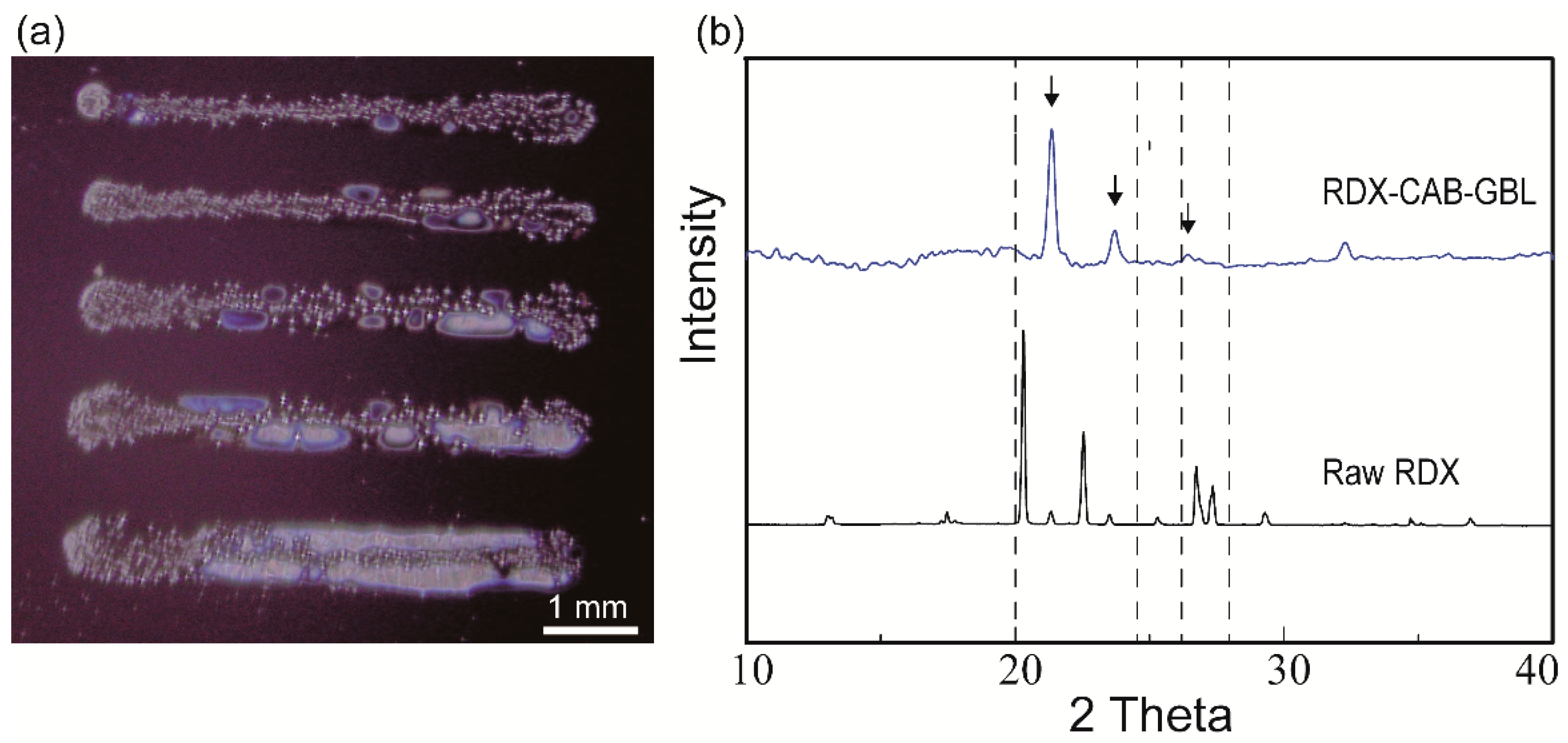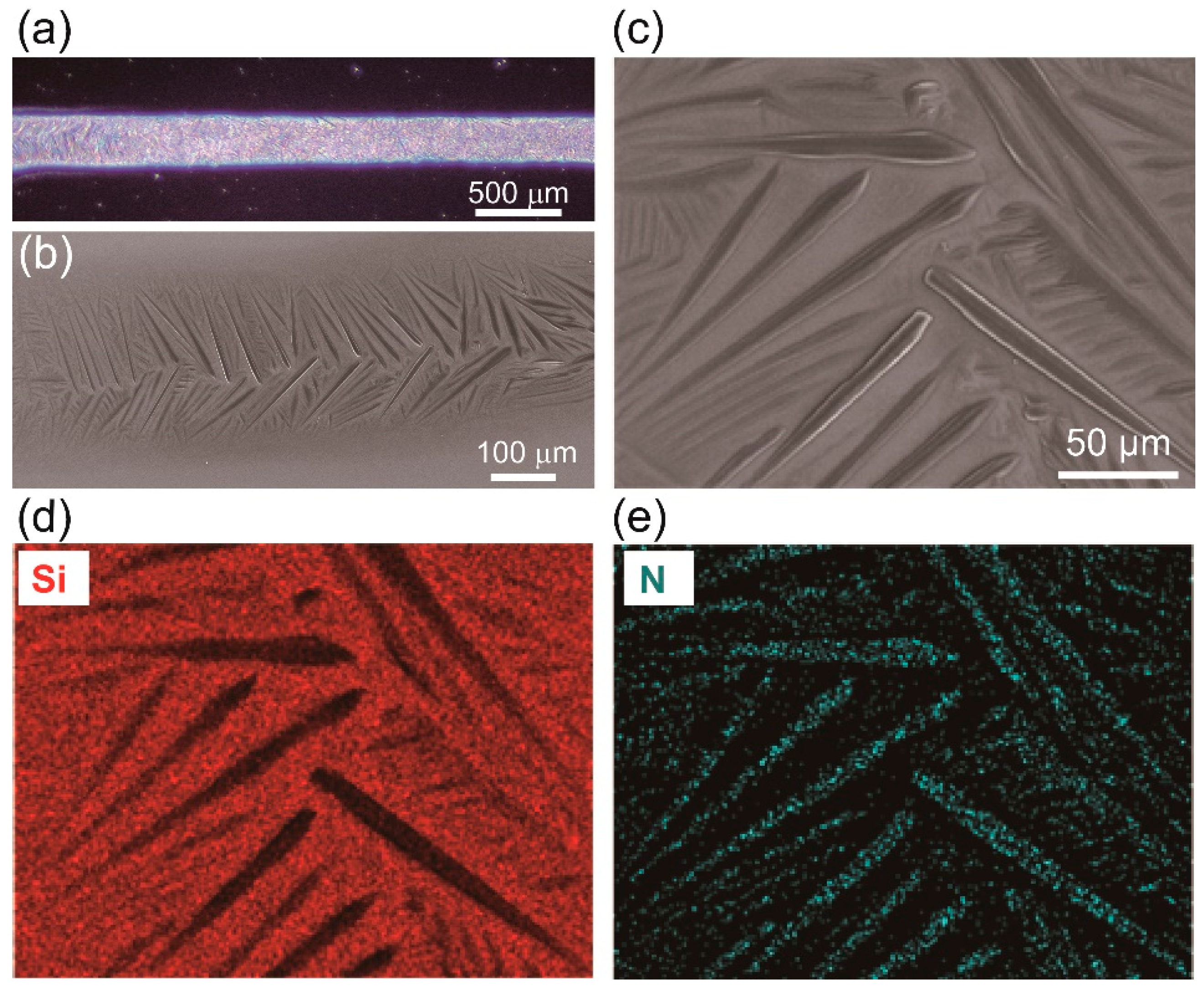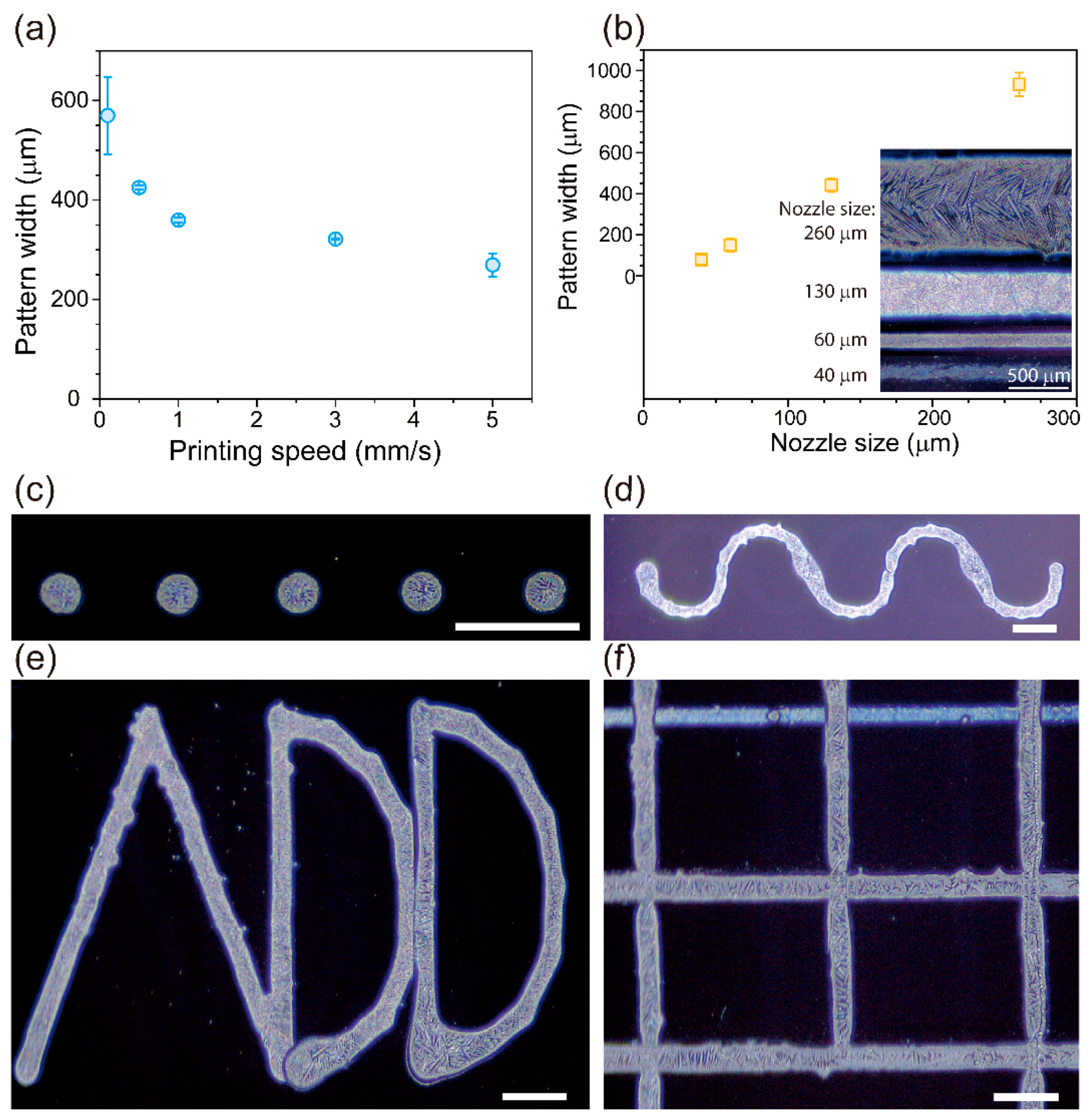A Simple Route of Printing Explosive Crystalized Micro-Patterns by Using Direct Ink Writing
Abstract
:1. Introduction
2. Materials and Methods
2.1. Chemicals and Materials
2.2. Preparation of RDX Inks
2.3. Preparation of the Silicon-Wafer Substrates
2.4. Printing of RDX Inks
2.5. Characterization of the Printed RDX Patterns
3. Results
3.1. Direct Ink Writing with RDX Ink and Its Printability
3.2. The Effect of Surface Treatment on Printed RDX Micro-Patterns
3.3. Printing of Long Micro-Pattern Arrays of RDX
4. Conclusions
Author Contributions
Funding
Institutional Review Board Statement
Informed Consent Statement
Data Availability Statement
Conflicts of Interest
References
- Xu, C.; An, C.; Long, Y.; Li, Q.; Guo, H.; Wang, S.; Wang, J. Inkjet printing of energetic composites with high density. RSC Adv. 2018, 8, 35863–35869. [Google Scholar] [CrossRef] [Green Version]
- Li, Q.; An, C.; Han, X.; Xu, C.; Song, C.; Ye, B.; Wu, B.; Wang, J. CL-20 based Explosive Ink of Emulsion Binder System for Direct Ink Writing. Propell. Explos. Pyrot. 2018, 43, 533–537. [Google Scholar] [CrossRef]
- Wang, D.; Zheng, B.; Guo, C.; Gao, B.; Wang, J.; Yang, G.; Huang, H.; Nie, F. Formulation and performance of functional sub-micro CL-20-based energetic polymer composite ink for direct-write assembly. RSC Adv. 2016, 6, 112325–112331. [Google Scholar] [CrossRef]
- Ihnen, A.C.; Petrock, A.M.; Chou, T.; Samuels, P.J.; Fuchs, B.E.; Lee, W.Y. Crystal morphology variation in inkjet-printed organic materials. Appl. Surf. Sci. 2011, 258, 827–833. [Google Scholar] [CrossRef]
- Nafday, O.A.; Pitchimani, R.; Weeks, B.L.; Haaheim, J. Patterning High Explosives at the Nanoscale. Propell. Explos. Pyrotech. 2006, 31, 376–381. [Google Scholar] [CrossRef]
- Tagliaferri, S.; Panagiotopoulos, A.; Mattevi, C. Direct ink writing of energy materials. Mater. Adv. 2021. [Google Scholar] [CrossRef]
- Patel, V.K.; Ganguli, A.; Kant, R.; Bhattacharya, S. Micropatterning of nanoenergetic films of Bi2O3/Al for pyrotechnics. RSC Adv. 2015, 5, 14967–14973. [Google Scholar] [CrossRef] [Green Version]
- Liu, L.; Xue, Y.; Xie, R.; Ren, X.; Li, K. Study on Performance of Silicon Ignitiors based on Energetic Chip of Porous Silicon. MATEC Web Conf. 2017, 100, 04002. [Google Scholar] [CrossRef] [Green Version]
- Muravyev, N.V.; Monogarov, K.A.; Schaller, U.; Fomenkov, I.V.; Pivkina, A.N. Progress in Additive Manufacturing of Energetic Materials: Creating the Reactive Microstructures with High Potential of Applications. Propell. Explos. Pyrotech. 2019, 44, 941–969. [Google Scholar] [CrossRef]
- Pezous, H.; Rossi, C.; Sanchez, M.; Mathieu, F.; Dollat, X.; Charlot, S.; Salvagnac, L.; Conédéra, V. Integration of a MEMS based safe arm and fire device. Sens. Actuators A Phys. 2010, 159, 157–167. [Google Scholar] [CrossRef]
- Pezous, H.; Rossi, C.; Sanchez, M.; Mathieu, F.; Dollat, X.; Charlot, S.; Conédéra, V. Fabrication, assembly and tests of a MEMS-based safe, arm and fire device. J. Phys. Chem. Solids 2010, 71, 75–79. [Google Scholar] [CrossRef]
- Zhang, L.; Zhang, F.; Wang, Y.; Han, R.; Yang, L. Preparation and Characterization of Direct Write Explosive Ink Based on CL-20. J. Phys. Conf. Ser. 2019, 1209, 012016. [Google Scholar] [CrossRef]
- He, Y.; Guo, X.; Long, Y.; Huang, G.; Ren, X.; Xu, C.; An, C. Inkjet Printing of GAP/NC/DNTF Based Microscale Booster with High Strength for PyroMEMS. Micromachines 2020, 11, 415. [Google Scholar] [CrossRef] [PubMed]
- Wang, F.; Zhang, L.; Li, L.; Qiao, Z.; Cao, Q. Design and Analysis of the Elastic-Beam Delaying Mechanism in a Micro-Electro-Mechanical Systems Device. Micromachines 2018, 9, 567. [Google Scholar] [CrossRef] [PubMed] [Green Version]
- Bodkhe, S.; Noonan, C.; Gosselin, F.P.; Therriault, D. Coextrusion of Multifunctional Smart Sensors. Adv. Eng. Mater. 2018, 20, 1800206. [Google Scholar] [CrossRef]
- Soum, V.; Park, S.; Brilian, A.I.; Kim, Y.; Ryu, M.Y.; Brazell, T.; Burpo, F.J.; Parker, K.K.; Kwon, O.-S.; Shin, K. Inkjet-Printed Carbon Nanotubes for Fabricating a Spoof Fingerprint on Paper. ACS Omega 2019, 4, 8626–8631. [Google Scholar] [CrossRef]
- Kim, Y.; Yuk, H.; Zhao, R.; Chester, S.A.; Zhao, X. Printing ferromagnetic domains for untethered fast-transforming soft materials. Nature 2018, 558, 274–279. [Google Scholar] [CrossRef]
- Rocha, V.G.; Saiz, E.; Tirichenko, I.S.; García-Tuñón, E. Direct ink writing advances in multi-material structures for a sustainable future. J. Mater. Chem. A 2020, 8, 15646–15657. [Google Scholar] [CrossRef]
- Pellegrino, P.M.; Holthoff, E.L.; Farrell, M.E. Laser-Based Optical Detection of Explosives; CRC Press: Boca Raton, FL, USA, 2018. [Google Scholar]
- Staymates, M.E.; Fletcher, R.; Verkouteren, M.; Staymates, J.L.; Gillen, G. The production of monodisperse explosive particles with piezo-electric inkjet printing technology. Rev. Sci. Instrum. 2015, 86, 125114. [Google Scholar] [CrossRef] [Green Version]
- Nguyen, T.T.; Phan, N.D.; Nguyen, C.D.; Do, T.V.; Bach, G.L. The Chemical Compatibility and Adhesion of Energetic Materials with Several Polymers and Binders: An Experimental Study. Polymers 2018, 10, 1396. [Google Scholar] [CrossRef] [Green Version]
- Lee, S.; Moon, T.; Kwon, K.; Kim, J.S.; Kim, J.; Shin, K. Matrix-Mediated Crystallization of Explosive Materials in Crosslinked Polymer Network. Sci. Adv. Mater. 2017, 9, 1–5. [Google Scholar] [CrossRef]
- Lee, S.; Lee, J.; Kwon, K.; Ko, E.; Lee, E.; Yu, C.-J.; Shin, K.; Kim, J. Synergy between ultrasonication and a polymer matrix in reducing particle size of molecular explosives during crystallization. CrystEngComm 2018, 20, 7423–7427. [Google Scholar] [CrossRef]
- Pant, A.; Nandi, A.; Newale, P.; Prakash, V.; Prasanth, H.; Pandey, R. Preparation and characterization of ultrafine RDX. Cent. Eur. J. Energ. Mat. 2013, 2013, 393–407. [Google Scholar]
- Vafaei, S.; Tuck, C.; Ashcroft, I.; Wildman, R. Surface microstructuring to modify wettability for 3D printing of nano-filled inks. Chem. Eng. Res. Des. 2016, 109, 414–420. [Google Scholar] [CrossRef]





Publisher’s Note: MDPI stays neutral with regard to jurisdictional claims in published maps and institutional affiliations. |
© 2021 by the authors. Licensee MDPI, Basel, Switzerland. This article is an open access article distributed under the terms and conditions of the Creative Commons Attribution (CC BY) license (http://creativecommons.org/licenses/by/4.0/).
Share and Cite
Brilian, A.I.; Soum, V.; Park, S.; Lee, S.; Kim, J.; Kwon, K.; Kwon, O.-S.; Shin, K. A Simple Route of Printing Explosive Crystalized Micro-Patterns by Using Direct Ink Writing. Micromachines 2021, 12, 105. https://doi.org/10.3390/mi12020105
Brilian AI, Soum V, Park S, Lee S, Kim J, Kwon K, Kwon O-S, Shin K. A Simple Route of Printing Explosive Crystalized Micro-Patterns by Using Direct Ink Writing. Micromachines. 2021; 12(2):105. https://doi.org/10.3390/mi12020105
Chicago/Turabian StyleBrilian, Albertus Ivan, Veasna Soum, Sooyong Park, Soojin Lee, Jungwook Kim, Kuktae Kwon, Oh-Sun Kwon, and Kwanwoo Shin. 2021. "A Simple Route of Printing Explosive Crystalized Micro-Patterns by Using Direct Ink Writing" Micromachines 12, no. 2: 105. https://doi.org/10.3390/mi12020105







